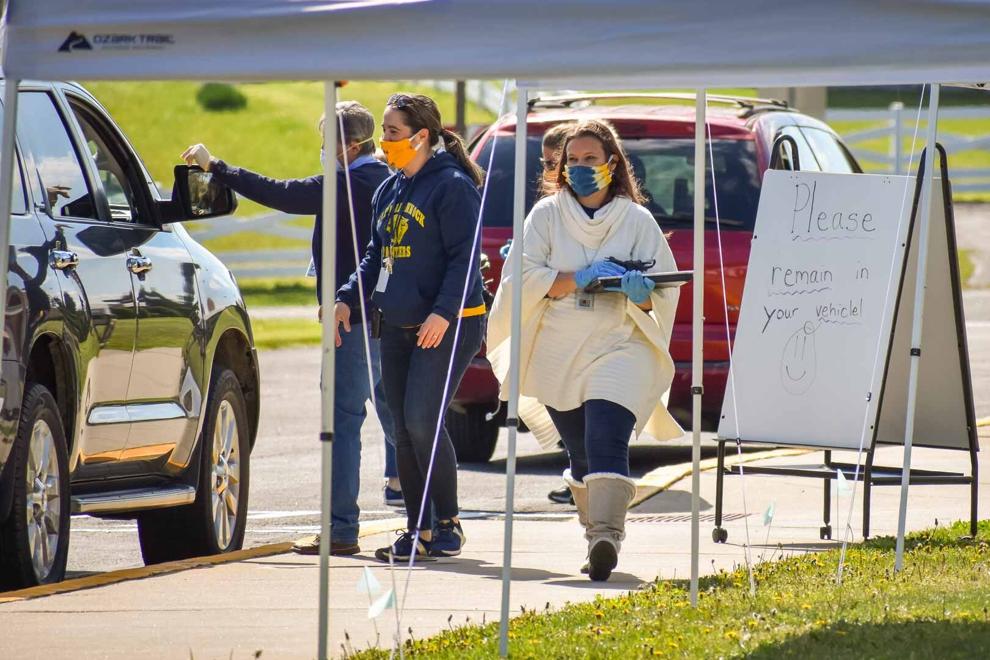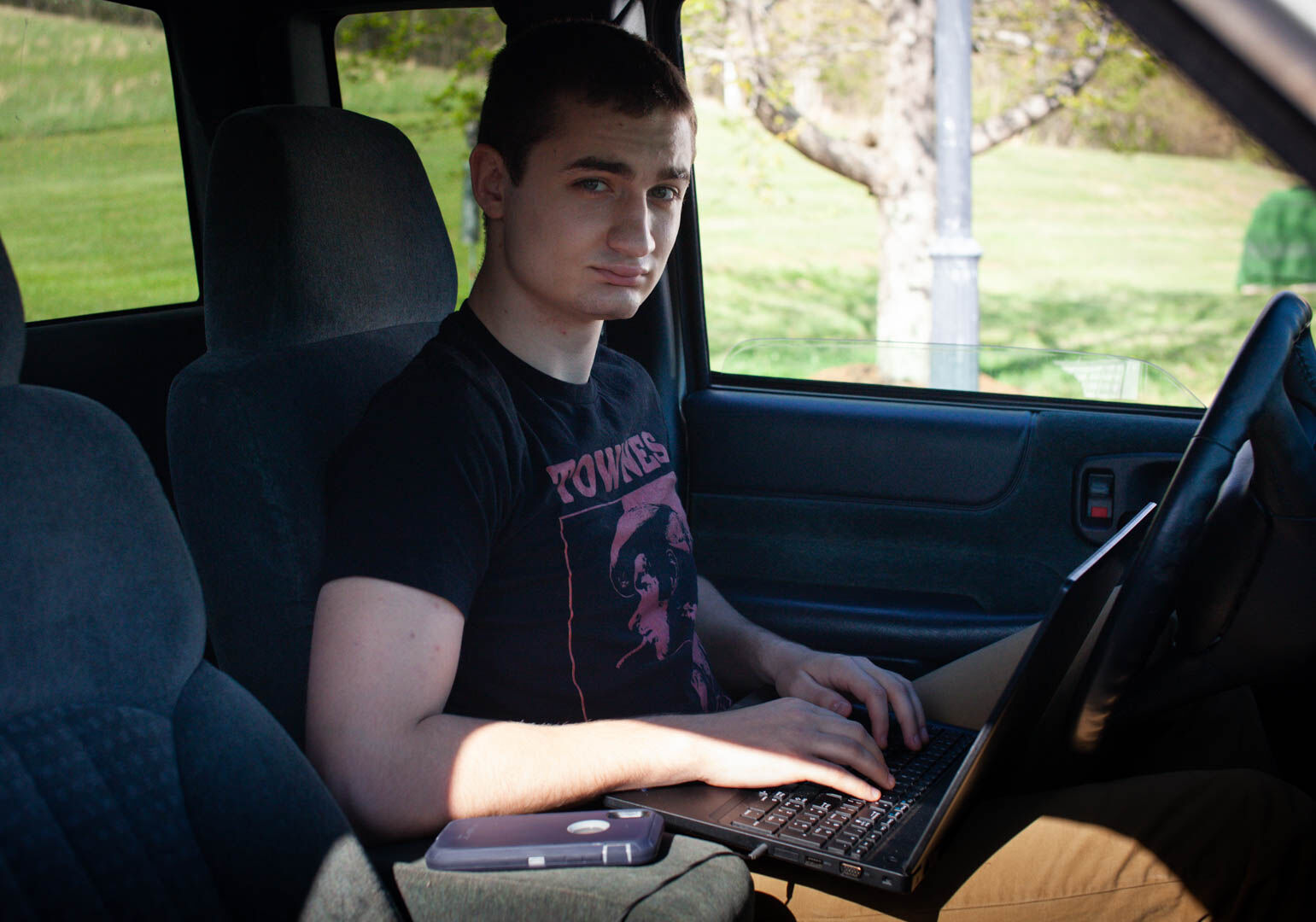Part 3 of 3: Foothills Forum and the Rappahannock News look back on 2020 with a focus on COVID-19 as well as several key issues – schools, broadband and cellular, business, housing — we have reported on throughout the year.
Pandemic ‘lit the match’ on acquiring broadband for county
The lack of reliable broadband service for swaths of Rappahannock County is hardly a new issue. But living with a pandemic the past 10 months has laid bare the disturbing consequences.
Students forced to shift to remote learning often have been handicapped in keeping up with schoolwork due to weak and undependable connections. For many, streaming video isn’t an option.
And, as group meetings and family gatherings have moved to Zoom and other video conferencing applications, a lot of Rappahannock residents have become painfully familiar with frozen images and garbled conversations.

(Photo/Luke Christopher)
Rappahannock’s sparse population – translating to a limited number of potential paying customers – and its challenging topography have long been a major disincentive for internet providers to invest heavily in infrastructure here. Also, in a county where a premium is placed on keeping taxes low and the treasured viewscape free of cell towers, local officials have been wary of wading too deeply into a broadband whirlpool.
But the fallout from COVID-19 brought things to a head.
“Having a lot of young people in the county who could not do their homework, that lit the match,” said Wakefield District Supervisor Debbie Donehey. “We gotta make something happen.”
The latest
That something came earlier this month when the Board of Supervisors voted to create the Rappahannock County Broadband Authority, an independent corporation that could enter into partnerships with private internet providers.
A critical distinction between the broadband authority and the broadband committee, which has served in an information-gathering and advisory role since it was formed in 2017, is that the authority has spending power and can apply for federal and state grants.
“I’m feeling much more hopeful,” said Margaret Bond, a member of the broadband committee who has been instrumental to the formation of a broadband authority. “Every one of the supervisors is really committed to this. We’re fortunate to have a more forward-thinking attitude.”
One potential partner is the Rappahannock Electric Cooperative (REC), which contacted county officials last spring to see if they wanted to be part of a project that could expand fiber optic service in Rappahannock.
The BOS pledged $100,000 to show its interest, but such an undertaking would be quite expensive, and is contingent on the REC receiving a sizable grant through a new Federal Communications Commission program called the Rural Digital Opportunity Fund (RDOF). A decision on that grant is expected soon.
“You’re not going to be able to do fiber optic broadband to every home. It’s just not feasible,” Donehey said. “But what REC does is make it much more possible for a larger percentage of the county to get fiber than other potential options.”
The BOS took another step in addressing its broadband quandary when it approved the updated version of the county’s Comprehensive Plan at the same December meeting. Added to the document is a section providing guidelines for considering zoning permits for wireless communications towers in the future.
The guidelines place a heavy focus on the need to limit the visual impact of such structures, emphasizing that they should be concealed or camouflaged as much as possible, with a goal of limiting the height and mass so a tower is “compatible with the surrounding area.”
County Administrator Garrey Curry said the point is to clearly define the county’s standards in such a way that could inform an ordinance regulating broadband and cell infrastructure.
“This community wouldn’t necessarily support a bunch of 199-foot-tall towers,” he said. “But maybe we would be a community that supports several well-hidden 80-foot towers.”
Two years ago, the BOS approved a 199-foot tall monopole on Woodward Rd. in Sperryville. Verizon and Piedmont Broadband are now providing service from the structure, and T-Mobile is expected to join them within the next month.
More recently, the supervisors gave the go-ahead to Community Wireless Structures (CWS) to erect a 199-foot monopole near Scrabble. But while the company has begun the zoning application and building permit process, it won’t start construction until it has a lease commitment from a telecommunications provider.
The BOS rejected a CWS proposal to build a similar monopole on Eldon Farms property near Woodville largely due to concerns that it could mar the view.
What’s next
The administrative part of launching the new broadband authority – adopting bylaws, electing officers, filing for incorporation with the state – will begin soon. Once it’s incorporated, the authority can start meeting with broadband providers.
Since it will be expected to contribute financially to any project, the authority will also need to focus on applying for state and federal grant money. But it’s too soon to say if it will be able to gear up fast enough to meet the next set of application deadlines in the spring.
Bond thinks that once the authority has a base of funds, its first project could be to pay for a well-engineered design plan to determine as precisely as possible how many potential subscribers are in the county. It could use such a plan, she said, to tailor future grant applications.
Recognizing the economic necessity of broadband in areas like Rappahannock, both the federal and state governments are now making big financial commitments to the expansion of rural broadband. Through the RDOF program, the FCC recently awarded $9.3 billion in grants nationwide to build out broadband systems over the next 10 years. About $240 million of that total will be funneled to projects in Virginia.
The state has its own rural broadband program, called the Virginia Telecommunications Initiative (VATI). During the 2020 fiscal year, it distributed $19 million to local governments and authorities to extend broadband service to unserved areas, and is expected to almost triple that amount in FY 2021. That’s in addition to $30 million that Virginia took from its federal CARES Act allocation and passed on to localities – including nearby Culpeper, Page and Orange counties – to boost broadband.
The availability of grant money will likely encourage broadband providers to take on projects in places they may have avoided in the past.
And there’s also a new player on the broadband field, one with a big footprint. It’s Elon Musk’s SpaceX, and it’s pressing ahead with an ambitious project called Starlink, through which thousands of small satellites in low Earth orbit will provide internet access in otherwise hard-to-reach areas. More than 900 of the satellites have already been launched.
In beta testing around the country, Starlink is delivering download speeds of up to 150 megabits per second, which is about six times faster than the HughesNet satellite service. But that level of performance comes at a high price; the equipment alone will cost an estimated $499, and service will initially run at $99 per month. Musk has described reducing equipment costs as “our biggest technical challenge.”
Still, Starlink’s potential has impressed the FCC. It recently awarded SpaceX almost $900 million in RDOF grants. The company received about $24 million — roughly 25% — of the grant money allocated to Virginia.
“The next 12 months,” Curry said, “will be very interesting in terms of what happens with broadband service.”
Debbie Donehey, Board of Supervisors representative on Broadband Committee
Her biggest concern: “Financial. We need to select a partner that will help us win substantial grants.”
What makes her hopeful: “Our citizens have a lot of knowledge, and I’m grateful they are willing to spend their free time working to better the lives of their friends and neighbors. With the Authority in place, we will be able to accept donations from generous citizens, as well as nonprofits.”
Margaret Bond, Broadband Committee member
Her biggest concern: “The scope of work for ensuring universal, adequate and affordable broadband services in Rappahannock County is formidable. There are many competing interests and rapidly changing technologies which present challenges.”
What makes her hopeful: “The members of the Board of Supervisors all share a sense of urgency in delivering the best practical broadband services to every residence and business in the county.”
BY THE NUMBERS: When schools were closed last spring, about half of Rappahannock public school students had to request a laptop or tablet from the school district in order to do their lessons at home. One-third of those needing devices had limited or no internet access and had to have their coursework preloaded.
The Series
Part 1: Intro and Business
Part 2: Housing and Budget
Part 3: Broadband and Schools
Rapp students adjust to a new reality
Last summer no fewer than nine different task forces wrestled with how to reopen Rappahannock County’s public schools in the middle of a pandemic.
They considered what kind of safety rules and equipment would be needed, how bus rides and school lunches would have to change, and how teachers could effectively adapt their lessons to virtual classes — something that couldn’t be done last March when Gov. Ralph Northam suddenly closed all Virginia public schools.
The resulting safety precautions have largely been successful. Since August, three students and two staff members have tested positive for COVID-19. The shift to online learning, however, and limited social interactions when students are at school has proven more challenging.
In October, Rappahannock High School Principal Jimmy Swindler sent an email to teachers calling for an all-hands-on-deck “student reboot” because at that point, the school was experiencing a failure rate of more than 40 percent.
“For the first nine weeks, everyone was trying to get their footing,” said School District Superintendent Dr. Shannon Grimsley. “Teachers and staff and students. It was a huge learning experience for everybody.”

April 21: Like other Rappahannock- based students whose colleges are closed, Drake Lynn, a 2018 graduate of Rappahannock Public High School, uses the RCPS Hotspot Hub at the library for his coursework at Virginia Tech. (Photo/Luke Christopher)
The latest
It became clear that many of the failing grades were due to students not finishing assignments while working from home at least three days a week. For a lot of kids, it was a rough adjustment.
Grimsley said the situation made it difficult for teachers to evaluate how much students were actually learning.
“In this scenario where we have so many remote learners, it becomes a question of whether the grades capture what students know and understand, or if the grades more reflect their remote learning behavior. That’s the crux of the issue,” she said.
So the district began to allow struggling students to come into the schools to work with teachers on Wednesdays – which had been an all-remote learning day. Now, almost 100 elementary and high school students are taking advantage of the more “individualized instruction,” according to Grimsley.
Students are also now able to attend Saturday study halls at the schools. It’s primarily an opportunity for them to use the high-speed internet connection. But that’s been less popular, and may be offered only every other weekend next semester.
Grimsley said her staff helped students set up at-home schedules so they have more structure in their virtual learning. Teachers have become more stringent in enforcing assignment deadlines than they were earlier in the year. But students, with their parents’ permission, can choose to go pass-fail in courses where they complete 70 percent of the work.
The adjustment to the safety rules seems to have gone more smoothly. “To my surprise, the masks were not as big a deal as we thought they would be,” said Kathy Sickler, the school district’s social worker. “We did have several months of mask-wearing in the community before they returned to school. So we haven’t seen resistance, even among the younger kids.”
It helps that teachers are giving students mask breaks, where they can go outside and walk around mask-free for a bit, or go into the gym and spread out.
Grimsley said the district was also able to use a grant from the state to upgrade the buildings’ HVAC systems in November.
“I think in terms of the flu and colds, we may be healthier this year than we’ve ever been,” she added.
But emotionally and socially, Grimsley said, the pandemic’s ripple effects have clearly taken a toll.
“Anxiety and depression are on the rise among our students,” she said. “It’s not a good situation for some of our at-risk students. And, even some of our students who you wouldn’t have considered at-risk before are really struggling.”
What’s next
One welcome development is the return of high school athletics. Boys and girls basketball is back, and wrestling matches are scheduled to start in January. The canceling of football and other fall sports exacerbated the students’ sense that a big part of their social lives has been lost, Sickler said.
But the revival of sports won’t be normal. Due to the latest round of restrictions imposed by the governor in response to a recent coronavirus spike in the state, only 25 spectators will be permitted to attend indoor events. The games will be live-streamed online.
“It’s going to be a tough thing for our students … not having many spectators or family members there,” Grimsley said.
The impact of social distancing has been particularly difficult for seniors, who see what they had hoped to be the highlight of their teen years slipping away. The school has made a point of arranging special events for them – a cookout, a doughnut social, a day when they could paint their parking spaces.
Sickler said that in the coming semester, if and when precautions can ease, seniors will be the first to benefit. “We’ll give them any kind of social treats that we can,” she said. “Seniors will be the first ones to get lunchroom privileges when it’s safe to do so.”
But much remains unclear about scheduling traditional events, such as the senior banquet and the prom.
“The social part of school is gone,” said Sickler. “People may walk around smiling, but kids tell me that school’s not much fun.”
Grimsley said she had hoped to be able to shift lower elementary school classes to a schedule of four in-person days a week in January, and then start phasing in higher grades. That plan, however, is on hold for now, although the school board is expected to reconsider it later this month, based on where things stand with the pandemic.
She said the school district has been trying to accommodate students and parents who want more in-school days. In some classes, that hasn’t been possible due to the social distancing restrictions, but in other cases, there’s been more flexibility.
Overall, the percentage of students having only remote learning has dropped from 23 percent in August to 17 percent by the end of the first semester. Also, a survey taken in December found that more remote students want to switch to a hybrid or four in-person day schedule. If all those requests were met – and some can’t be – the share of all-remote students would drop to 14 percent.
There’s also a growing desire among students to not feel so isolated.
“The current situation is definitely disassociating them from their peers. Kids are so separated all the time,” said Grimsley. “They’re yearning for that time with their friends.”
That said, she’s been impressed by how well students have stuck with following the rules that have so profoundly altered their school lives.
“That’s what has surprised me the most, how well they’re doing in adapting to all the changes,” Grimsley said. “I think the adults may be having a harder time with it.
“The kids are managing that. I think they understand what we’re dealing with, how serious it is, and that we all need to help each other.”
Dr. Shannon Grimsley, RCPS Superintendent

April 15: RCPS Superintendent Dr. Shannon Grimsley helps distribute laptops to students in need. (Photo/Holly Jenkins)
Her biggest concern: “There’s always a weight on your shoulders because you want to keep everyone as safe as possible. What keeps me up at night is that I can’t make school completely risk-free.”
What makes her hopeful: “I can’t say how proud I am of my staff, but also our parents. They’ve been doing a great job – calling in and asking the right questions; recording symptoms and making sure they do the right thing. Plus, the support the community has shown our school system.”
Kathy Sickler, RCPS Social Worker
Her biggest concern: “How much longer is this going to last? As the financial stress gets worse for families, the kids are picking up on that. They feel that anxiety.”
What makes her hopeful: “I see a lot of community projects happening to try to provide more social opportunities for the kids. That makes me hopeful that our community is resilient, and we can be there for each other.”
By the numbers
Because it received $527,000 in federal CARES Act funding, another $143,000 from the state, and a $29,000 Vision grant from the Virginia Department of Education to help cover technology costs, the school district was able to return $345,000 to the county.







